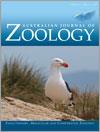Population studies often assume temporally stable and consistent patterns of genetic variability. Violations of this assumption can lead to misrepresentation of the amount and patterns of genetic variability in natural populations, which can be problematic in basic research and environmental monitoring studies that are designed to detect environmental perturbation. We collected two endemic species of amphipods, Melita plumulosa and Melita matilda, in a major eastern Australian waterway between November 2009 and October 2011, and assessed genetic variation at the mitochondrial cytochrome c oxidase subunit I locus. Overall, M. plumulosa was found to be more genetically variable than M. matilda. No distinct temporal trends in levels and patterns of genetic variation were identified in either species. These findings, combined with the published results demonstrating that M. plumulosa has greater sensitivity to a range of sediment-bound metals and organic contaminants, suggests it to be an informative species for environmental monitoring purposes.
How to translate text using browser tools
10 June 2014
Assessment of temporal genetic variability of two epibenthic amphipod species in an eastern Australian estuarine environment and their suitability as biological monitors
Pann Pann Chung,
Ida Chu,
J. William O. Ballard
ACCESS THE FULL ARTICLE

Australian Journal of Zoology
Vol. 62 • No. 3
August 2014
Vol. 62 • No. 3
August 2014
crustacean
cytochrome c oxidase subunit I
environmental monitoring
genetic variation
Melita matilda
Melita plumulosa




